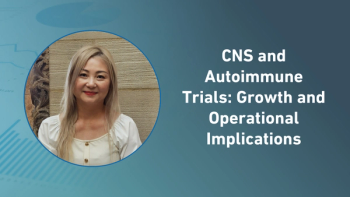
- Applied Clinical Trials-02-01-2021
- Volume 30
- Issue 1/2
Impact of COVID-19 on Phase I Clinical Activities
Life sciences companies challenged by need to minimize health risks without sacrificing data quality during pandemic.
The COVID-19 pandemic has hampered the conduct of clinical trials significantly and still creates unprecedented challenges to date. Phase I studies with healthy volunteers are particularly affected as uncertainty on viral spread among the population may call into question safety concerns and potential impact clinical data quality.
Complete lockdown forced stoppage of any new activity
When the pandemic struck in March 2020, stringent government regulations all over the world forced many countries to go into lockdown. As all non-essential movement was forbidden, many businesses were forced to close and everyday activities were reduced to the essentials. Life science companies and clinical trial facilities were
no exception.
Regulatory agencies published guidance on how to manage clinical trials, stating that priority was to be given to COVID-19 studies, in turn slowing down and even halting non-COVID-19 trials. The feasibility and immediate necessity of starting a new clinical trial needed to be
critically assessed.
As a consequence, our SGS Clinical Pharmacology Unit (CPU) in Belgium was closed at the start of the crisis to ease the burden on the healthcare system as much as possible. This meant that the recruitment of any new cohorts was completely put on hold and only minimal activity (necessary for subject follow-ups in ongoing trials) was allowed.
Reopening SGS Phase I unit by adopting COVID-19 risk implementation plan
Following the first pandemic’s peak, with the case rate falling, government restrictions became less stringent. And SGS CPU management reached out to the FAHMP (Federal Agency for Medicines and Health Products) through BAPU (Belgian Association of Phase I Units) to obtain the green light for restarting clinical activities. This would only be granted providing SGS CPU could organize all activities in compliance with local pandemic-related regulations. Therefore, to ensure a safe re-opening of the unit in alignment with rules set by the government, regulatory authorities, local hospitals, the local ethics committee and SGS’s company policy, a COVID-19 risk implementation plan was created.
The local hospital’s Board of Directors and our ethics committee were approached to review the COVID-19 risk implementation plan. Special focus was given to assessing the hospital’s situation, ensuring subject safety could be maintained using hospital facilities, while avoiding the risk of overloading emergency departments and intensive care units. Based on the scheduled trials, the risk of adverse events was evaluated to be low, therefore all parties agreed to SGS CPU re-opening. From June 2020, SGS CPU restarted clinical trial activities (in close collaboration with our clients) at a reduced capacity in line with social distancing guidelines.
The COVID-19 risk implementation plan was based on three key factors, 1) to avoid the potential spread of the virus, 2) to ensure the safety of the trial participants, staff, and visitors, 3) to ensure the quality of trial data.
Hygiene measures were set up for subjects, visitors, and staff, in line with government recommendations. These included regular hand washing and disinfecting with alcohol gel, compulsory wearing of face masks, and social distancing of 1.5 meters (5 feet) at all times. To highlight distancing measures, floor stickers were used to create one-way routes through the facility. Additional measures for staff included signage on doors displaying maximum capacities for offices and meeting rooms. Extra chairs were also removed to avoid exceeding the maximum capacities across the facility. And the staff was instructed to work from home whenever possible.
One precautionary measure was adapting standard operational activities to minimize the risk of potentially infected subjects accessing the site. Telephone interviews prior to visits were introduced using structured questionnaires. Additionally, each CPU reception area was equipped to measure temperatures. Following evaluation, bed capacity was reduced by 20 beds, and plastic screens were put in place where applicable.
Now, instead of the standard screening process, subjects are provided with the Informed Consent Form (ICF) and the CPU in-house rules via email before arriving at the unit. Individual screening appointments are foreseen.
Similarly, upon admission, subjects are invited to individually scheduled appointments. Each ward in the SGS Phase I unit has also been reorganized to enforce a one-way traffic system, with particular attention paid to disinfecting toilets, bathrooms, dining and recreation rooms, and fixed furniture across wards.
To reduce the number of people present at the unit, audits and data monitoring are organized remotely as much as possible. As a rule, the number of monitors, visits, and the length of time in the monitoring room is limited to a minimum. Using eSource in our unit, most data can be
reviewed remotely.
An important asset to control and mitigate the risk of viral spread is consistent COVID-19 testing. After the first pandemic peak, SGS CPU expanded its capacity of state-of-the-art PCR (BioFire, FilmArray), so that testing for SARS-CoV-2 can take place on-site, with results available within one hour. No longer relying on external partners for results has allowed large-scale testing to take place, which has proven invaluable when handling Belgium’s second COVID-19 wave in November 2020.
Upon every admission onto the site, routine SARS-CoV-2 testing is performed, and volunteers are only admitted after a confirmed negative result. During in-house stays, any individual possibly displaying COVID-19 symptoms is immediately isolated, evaluated by a physician (which can also be done by phone outside of working hours), and is nasally swabbed for PCR testing. When the test result returns negative, the subject returns to the ward. If positive, the subject must stay in isolation within the CPU, and the investigator and sponsor mutually evaluate the subject’s safety and continuation in the trial. This means the subject can remain quarantined at CPU for safety reasons or can be sent home to go into quarantine. Follow-up visits can be scheduled as soon as deemed safe. Even though no high-risk contact occurs within the unit, given the permanent preventive measures, all low-risk contacts are still traced and tested as appropriate.
Similarly, staff is instructed to stay at home when feeling the slightest viral symptom or when having had a potential high-risk contact. The medical team then decides on the testing strategy and follow-up steps.
All these steps have been summarized in a decision tree that visualizes the appropriate course of action in the case of a suspected COVID-19 infection within the unit, for both trial subjects and staff.
Moving forward in uncertain times
After the unforeseen lockdown during the first pandemic, the unit reopened implementing a series of measures to assure safe operational activities in uncertain times. Facing the second wave in November, the risk mitigation plan proved to be efficient as only 0.54% of all tests performed were positive, with only 0.27% of tests occurring during clinical trial conduct but with no impact on safety or data quality. The remaining tests occurred during follow-ups and at the end of the trials. It must be noted that during this period, the weekly ratio of positive tests in Belgium reached a peak of 29.2% and 19.2% in Antwerp.
Currently, entering 2021, the positivity ratio has declined again to 5.3% and 4.8% for Belgium and the Antwerp region respectively. However, as a lesson learned, governments are weary to loosen rules too quickly and a semi-lockdown situation is still the default in most European countries, including Belgium. Also, at our CPU, we continue to work with the highest precautions and risk mitigation in place.
Clinical trials are essential, and continuation must be ensured. As infection rates seem to go up and down in waves, and new viral mutations cause concerns, COVID-19 risk mitigation will be part of our common practice for some time. Measures may change in line with the epidemiological situation, but general approaches of social distancing and hygiene appear to stay for the foreseeable future. Only now, with vaccination campaigns being rolled out at speed, can we start looking forward to a more normal life hopefully after the summer.
Katrien Lemmens, Medical Director, Clinical Pharamcology Unit, SGS Life Science Services
Articles in this issue
almost 5 years ago
Diversity in Clinical Trials Gains Ground Amidst COVIDalmost 5 years ago
Biden Pandemic Plan Highlights R&D Supportalmost 5 years ago
Applied Clinical Trials, January/February 2021 Issue (PDF)almost 5 years ago
New Alliance Seeks to Bring Increased Accessibility to Trialsalmost 5 years ago
Improving Drug Development for Rare Patients Post-COVIDalmost 5 years ago
2021 Promises for Clinical Trialsalmost 5 years ago
Sharpening the Focus on Patient-Centricity as Pandemic Continuesalmost 5 years ago
News Notes (January & February)almost 5 years ago
EMA’s Cooke Reviews European Cancer Prospectsalmost 5 years ago
Characterizing Clinical Data Management Challenges and Their ImpactNewsletter
Stay current in clinical research with Applied Clinical Trials, providing expert insights, regulatory updates, and practical strategies for successful clinical trial design and execution.






.png)



.png)



.png)
.png)
